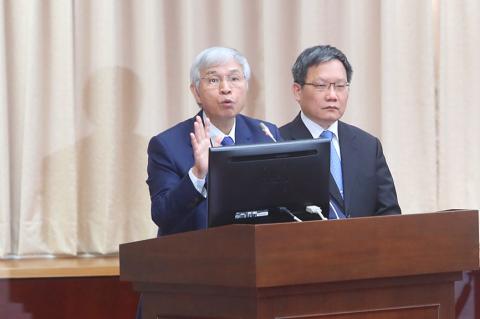The central bank yesterday kept policy rates unchanged for the 10th consecutive quarter, saying that a global economic slowdown and the US-China trade dispute merited a lenient policy.
The monetary policymaker trimmed its GDP growth forecast for this year to 2.68 percent from the 2.7 percent it predicted in September, and is anticipating a 2.33 percent pickup next year.
“The domestic stock rout has taken a toll on consumer spending, while economic weakness in major trading partners might dampen external demand,” central bank Governor Yang Chin-long (楊金龍) told a news conference after the bank’s quarterly board meeting.

Photo: CNA
Against this backdrop, the board unanimously agreed to hold the rediscount rate steady at 1.375 percent, the collateralized loan rate at 1.75 percent and the unsecured loan rate at 3.625 percent.
The downward GDP growth revision came after international research institutes cut forecasts for major economies and turned cautious, Yang said.
Taiwan, home to some of the world’s biggest electronic component suppliers, is susceptible to cyclical global technology corrections and effects of hostile tariff exchanges between Washington and Beijing, as such components account for more than half of all exports.
A conservative outlook led the bank to keep its target range for broad money supply next year unchanged at 2.5 percent to 6.5 percent, Yang said.
The bank expects consumer prices to increase 1.05 percent next year, while the consumer price index, a reliable long-term price tracker, would advance at a milder 0.93 percent, Yang said.
International oil prices have stabilized, easing imported inflationary pressures, the governor said, adding that stable consumer prices gave the bank room to adopt an accommodative monetary policy.
Yang declined to comment on policy rate changes next year, saying that the bank would base its decisions on the latest economic figures.
“Moves by other central banks will serve as a reference, but will not be the decisive factor,” he said.
Yang, who has a doctorate in economics, declined to comment on movements of the US dollar or capital flows, saying that most predictions have proved to be inaccurate.
He dismissed criticism that the bank failed to do anything to curb capital flight to pursue higher returns in US dollar-denominated assets following a series of rate hikes by the US Federal Reserve.
The capital outflows wreaked havoc on the local bourse, but also led to higher dividend payouts this year, Yang said.
Dividend payouts this year totaled NT$1.4 trillion (US$45.3 billion), up 11.8 percent from last year, with NT$460 billion wired overseas to foreign investors, the bank said.

GROWING OWINGS: While Luxembourg and China swapped the top three spots, the US continued to be the largest exposure for Taiwan for the 41st consecutive quarter The US remained the largest debtor nation to Taiwan’s banking sector for the 41st consecutive quarter at the end of September, after local banks’ exposure to the US market rose more than 2 percent from three months earlier, the central bank said. Exposure to the US increased to US$198.896 billion, up US$4.026 billion, or 2.07 percent, from US$194.87 billion in the previous quarter, data released by the central bank showed on Friday. Of the increase, about US$1.4 billion came from banks’ investments in securitized products and interbank loans in the US, while another US$2.6 billion stemmed from trust assets, including mutual funds,

Micron Memory Taiwan Co (台灣美光), a subsidiary of US memorychip maker Micron Technology Inc, has been granted a NT$4.7 billion (US$149.5 million) subsidy under the Ministry of Economic Affairs A+ Corporate Innovation and R&D Enhancement program, the ministry said yesterday. The US memorychip maker’s program aims to back the development of high-performance and high-bandwidth memory chips with a total budget of NT$11.75 billion, the ministry said. Aside from the government funding, Micron is to inject the remaining investment of NT$7.06 billion as the company applied to participate the government’s Global Innovation Partnership Program to deepen technology cooperation, a ministry official told the

Taiwan Semiconductor Manufacturing Co (TSMC, 台積電), the world’s leading advanced chipmaker, officially began volume production of its 2-nanometer chips in the fourth quarter of this year, according to a recent update on the company’s Web site. The low-key announcement confirms that TSMC, the go-to chipmaker for artificial intelligence (AI) hardware providers Nvidia Corp and iPhone maker Apple Inc, met its original roadmap for the next-generation technology. Production is currently centered at Fab 22 in Kaohsiung, utilizing the company’s first-generation nanosheet transistor technology. The new architecture achieves “full-node strides in performance and power consumption,” TSMC said. The company described the 2nm process as

Even as the US is embarked on a bitter rivalry with China over the deployment of artificial intelligence (AI), Chinese technology is quietly making inroads into the US market. Despite considerable geopolitical tensions, Chinese open-source AI models are winning over a growing number of programmers and companies in the US. These are different from the closed generative AI models that have become household names — ChatGPT-maker OpenAI or Google’s Gemini — whose inner workings are fiercely protected. In contrast, “open” models offered by many Chinese rivals, from Alibaba (阿里巴巴) to DeepSeek (深度求索), allow programmers to customize parts of the software to suit their